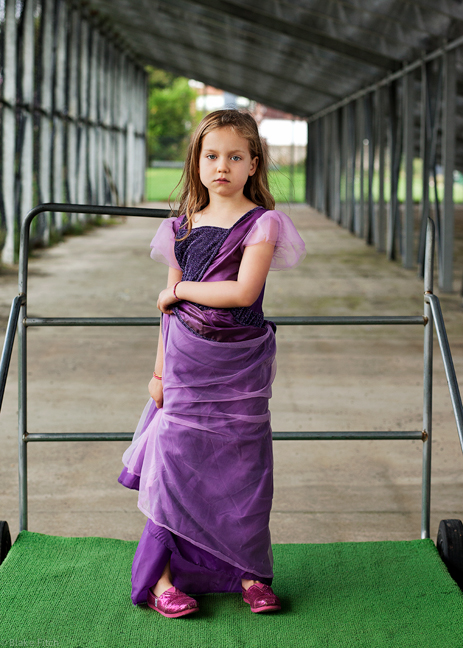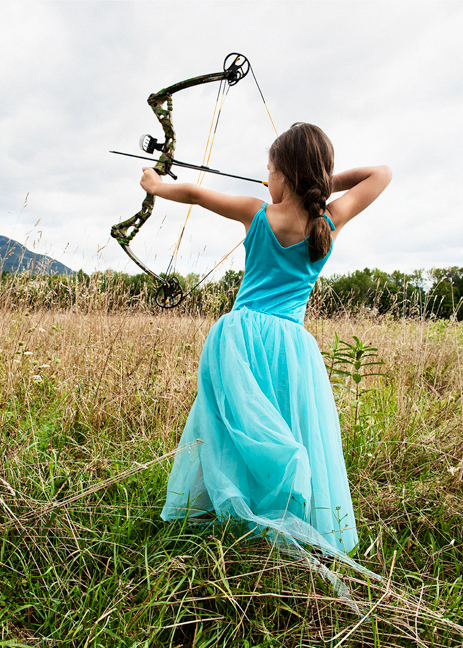Blake Fitch: Dress Rehearsal
Work seen at PhotoNOLA …

Blake Fitch brought an interesting, well-seen project to PhotoNOLA, Dress Rehearsal, that depicts young girls in one of their favorite Princess character costumes. As a photographer and mother, she is a participant observer of her daughter’s world of play and the current contemporary templates for adulthood that big business thrusts upon children. Blake has a hyper sensitivity to these observations. Her earlier project, Expectations of Adolescence examined her half-sister and cousin from age 12 through 22 which allowed a window into “the mercurial transition period when girls feel alternatively awkward and self-confident, combative and submissive, childlike in their wonder, but budding adults in their growing knowledge of the world.”
“Dress Rehearsal is created within the context of the current Disney “Princess Culture” (“PC”) and her photographs are not a polemic on the effects of PC on the psyche of young girls, but rather suggest that reflection and scrutiny will prove enlightening”.
Blake received her BFA on full scholarship from Pratt Institute, with a major in photography and minor in photo history. She studied photography at the Art Institute of Chicago, before earning her master’s degree in arts administration at Boston University. From 2002 through 2007, Blake was executive director of the Griffin Museum of Photography in Winchester, MA, where she was instrumental in making the museum a preeminent resource devoted to the exhibition of photography.
The quality and breadth of her imagery has enabled Blake to receive a variety of grants and sponsorships, including support from Kodak and Calumet Photographic. Her work has been exhibited internationally, and is held in the collections of numerous private and public collections, including the Museum of Fine Arts Houston, The George Eastman House of Photography, and the Worcester Art Museum. She is represented by ClampArt. Fitch continues to curate independently and work as a fine artist and commercial photographer. She teaches at the New England School of Photography and lives in Reading, MA, with her husband and their two children.
“Dress Rehearsal” examines a contemporary rite of passage when young girls immerse themselves in all-things princess. These photographs are quiet constructions of girls dressing up as princesses and “trying on” femininity for the first time. Additionally, these photographs capture the girls’ exposure to various aspects of gender indoctrination and how they embrace a budding sense of power and strength. These surprisingly sophisticated young girls, excited and empowered by wearing princess outfits, expand the traditional notion of girlhood and, unwittingly, emerge as new, modern constructs of the princess warrior.
As the mother of a four-year-old daughter, it was inevitable that I learn about the media phenomenon known as the Princess Culture (“PC”), developed by the media merchandising giant, Walt Disney. Introduced in the early 2000s to boost anemic sales in its consumer products division, PC has rocketed Disney sales into the stratosphere, causing other companies to jump onto the PC bandwagon. By re-branding its earlier movie princesses as well as creating new ones, Disney appeals to the previously-untapped demographic of young girls playing princess.

Now a generational touchstone, PC is a provocative cultural barometer and perhaps predictably, debate has followed among mothers and media critics. Some view PC as a normal girly-girl phase, while others think PC’s role models encourage girls to define themselves based on appearance and passivity, thereby undermining the development of their intelligence and self-confidence.

In my generation, girls dressed up their dolls and played with them; now they dress up themselves as dolls, a true sea change. Both then and now, Snow White and the Seven Dwarfs, Cinderella and Sleeping Beauty—the Disney trifecta— are viewed by every generation. Then these classics were within the broader culture of books, toys and games when the Disney brand was one of many. Now there’s a tsunami of both non-PC and PC Disney products (25,000 and counting), from tiaras to jump ropes to Legos, all being branded in Pantone pink #241 corona, the official color of the Disney Princess franchise.

When I was a child I did not play princess but the Cinderella narrative secretly intrigued me. My mom, a free-spirited, native Californian, an artist and teacher, as well as a member of the ‘70s feminist generation encouraged me to be creative and freethinking, and taught me the necessity and value of being assertive and self-assured. I have fond memories of camping out in our backyard, tromping through the creek nearby, watching Sesame Street, and acting out stories with my dolls. I also vividly recall spending hours singing songs from the popular Marlo Thomas and Friends record “Free to Be…You and Me”. Exposure to this media provided even more support, by buttressing my assertiveness in searching for my authentic identity, unencumbered by gender expectations and stereotypes. Paradoxically, my prince charming fantasy and expectations co-existed, rather happily, within my psyche.

Today, I witness my daughter exploring her femininity by playing princess, and I find myself experiencing conflicting emotions. I know this play is a phase, but I am weary that my daughter will become PC-enthralled and caught in its grip. Peggy Orenstein’s words resonate with me:
“And what was the first thing that culture told her about being a girl? Not that she was competent, strong, creative or smart, but that every girl wants—or should want—to be the Fairest of Them All.” Like Orenstein, I must learn to help and accompany my daughter through “the contradictions they will inevitably face as girls, the dissonance that is as endemic as ever to growing up female.”

The PC battleground thrives in articles, blogs and books, and Disney has been paying attention. The new iteration of Disney princesses as role models is more palatable for some; Merida (from Brave) and Anna and Elsa (from Frozen) are often cited. Andrea Phillips writes, “coming out of princess culture, you see girls who know what they want and are determined to go after it. You see girls who stand their ground, girls who use their voices.” Sasha Brown-Worsham suggests that mothers take a deep breath and calm down: “I think it’s fine that she worships at the altar of purple and wants to wear sparkly things and ‘something beautiful’ every morning. She is a girly girl who also loves to pretend sword fight, climb trees, run faster than the boys and wrestle.”

The debate continues, but this is what I know. I am my daughter’s No. 1 role model. Watching her experience the simple pleasures of childhood- bonding with her friends, delving into books, playing imaginatively- is my greatest joy. Under my loving guidance, my hope is that she can attain all that she desires, and will become an empowered young woman who can switch effortlessly from wearing cleats on the soccer field to high heels at the dance.
Posts on Lenscratch may not be reproduced without the permission of the Lenscratch staff and the photographer.
Recommended
-
Martin Stranka: All My StrangersDecember 14th, 2025
-
The Family Album of Ralph Eugene Meatyard at the High MuseumDecember 10th, 2025
-
Paccarik Orue: El MuquiDecember 9th, 2025
-
Richard Renaldi: Billions ServedDecember 6th, 2025
-
The Art of Documentary Photography: Rania MatarOctober 25th, 2025






































































